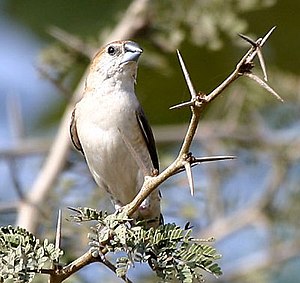Indian silver beak
| Indian silver beak | ||||||||||||
|---|---|---|---|---|---|---|---|---|---|---|---|---|

Indian silver beak ( Euodice malabarica ) |
||||||||||||
| Systematics | ||||||||||||
|
||||||||||||
| Scientific name | ||||||||||||
| Euodice malabarica | ||||||||||||
| ( Linnaeus , 1758) |
The Indian silver beak ( Euodice malabarica , syn .: Lonchura malabrica ), also called Malabar pheasant , is a species of the finch family (Estrildidae). No subspecies are distinguished.
The species is kept relatively often as an ornamental bird in Europe.
description
The Indian silver beak reaches a body length of eleven to twelve centimeters and weighs an average of twelve grams.
The plumage is predominantly brownish. The skull, back and upper wing-coverts are light brown. The rump and the upper tail coverts are white, with the outer upper tail coverts having black feather trimmings. The wings and the stepped tail are black-brown. The middle feathers of the tail are pointed lanceolate. The sides of the head are whitish. The underside of the body is creamy white and becomes a little brown on the sides of the body. The eyes are brown, the upper beak is dark blue-gray while the lower beak is a little lighter.
The Indian silver beak can be distinguished from the African silver beak, which belongs to the same genus, by its white rump plumage . In contrast to the African silver beak, the edge of the eyelid is not noticeably raised from the head plumage.
Young birds are monochrome, dark brownish-gray, the underside of the body is only slightly lightened. The wings and the tail are black-brown. Their beak is still completely black.
Distribution area and habitat
The distribution area of the Indian silver beak is very large. It extends from Pakistan over the foothills of the Himalayas , possibly also the southeast of Afghanistan , to Nepal and Sikkim . In the southern direction of distribution, the Indian silver beak occurs as far as Kerala and Madras . It also colonizes the arid areas in the northeast and southeast of Sri Lanka . There are also deposits in the Muscat region in southeastern Arabia, in northern Oman and in the United Arab Emirates . These may be due to refugees in prison . There have been breeding occurrences in Israel since 1983 and in Jordan since 1989 .
The habitat is steppes and savannahs with dense bushes as well as forest edges and light forest, but also the environment of human settlements. The altitude distribution ranges from sea level to altitudes of 1,300 meters. In the Himalayas, the species occurs in places up to 2,000 meters in altitude.
Way of life
The Indian silver beak mainly eats small seeds. Grass seeds are the main source of nutrition. It picks them up from the ground, but like numerous other fine finches is able to pick them up from the stalk of ears and panicles. In the south of India, the Indian silver beak is a pest that causes damage, especially in millet and rice fields, alongside the nutmeg finch , the black-bellied nun , the pointed-tail bronze man and the white-bellied bronze man .
The species can often be observed in schools. The need for socializing of the Indian silver beak remains so pronounced even during the breeding season that the parent birds join together with other conspecifics in groups during the breeding and hatching breaks. Contact sitting and mutual feathering are also very common.
The breeding season varies depending on the location. In high-altitude distribution areas, the birds breed in the summer months from June to September, in other regions in all seasons. However, the peak of reproductive activity usually occurs around the beginning of the monsoons. In Sri Lanka, Indian silver beaks breed accordingly from October to early April. The spherical nest is usually built very low above the ground. The clutch usually consists of six eggs. The breeding season is only eleven to twelve days. The young birds have an almost black skin color immediately after hatching. The nestling period is nineteen to twenty days. After leaving the nest, the young are looked after by the parent birds for another two weeks.
Systematics
Indian silver beak and African silver beak are sometimes combined into one species. The two differ not only in the plumage drawing, but also have very large differences in song and show different tail movements. They are therefore also understood as two species that together form a superspecies .
Keeping as an ornamental bird
The first maintenance of the Indian silver beak in Europe can no longer be reconstructed. In India this species was a popular pet bird in the 19th century; In Europe, the closely related African silver beak was and is kept much more frequently than this species. Indian silver beaks are considered an easy-to-keep species that is also very easy to breed. They can be kept both in the cage and in the aviary .
supporting documents
literature
- Horst Bielfeld : Knowing and caring for 300 ornamental birds. Ulmer Verlag, Stuttgart 2009, ISBN 978-3-8001-5737-2 .
- Jürgen Nicolai (Ed.), Joachim Steinbacher (Ed.), Renate van den Elzen, Gerhard Hofmann: Prachtfinken - Australia, Oceania, Southeast Asia. Eugen Ulmer Verlag, Stuttgart 2001, ISBN 3-8001-3249-4 .
- Peter Clement , Alan Harris, John Davis: Finches and Sparrows. An Identification Guide. Christopher Helm, London 1993, ISBN 0-7136-8017-2 .
Web links
- Euodice malabarica inthe IUCN 2013 Red List of Threatened Species . Listed by: BirdLife International, 2012. Retrieved November 24, 2013.



